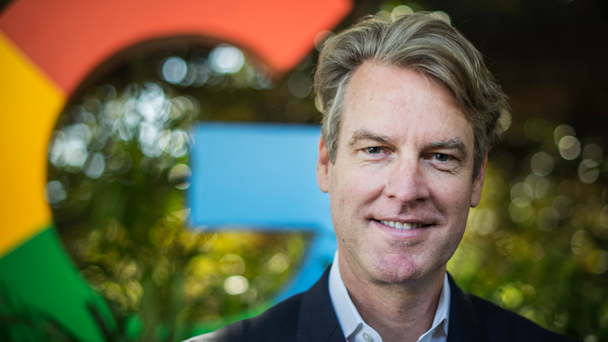3 actionable insights with... Google Americas president Allan Thygesen
The Drum’s 3 Actionable Insights series asks top industry leaders to share their thoughts about the actions our readers should take immediately. Today, Google Americas president Allan Thygesen dives into privacy and the future of Floc, the need for automation and taking measurement to the next level.

Google’s Thygesen says privacy, automation and measurement are marketers’ three priorities
1. Marketers must meet consumers’ rising privacy expectations
It’s so critical that all marketers endeavor to be privacy safe, because marketers are at risk of losing people’s trust. Protecting people’s privacy is really how we earn the right to be invited into their lives. And by privacy safe, what I really mean is how are we collecting people’s data? And how do we use it?
Most consumers may not understand the nitty gritty of how all the advertising they see works, but they do know that we’re using data to understand them and meet their needs. And then there are higher expectations for how that is handled. That’s the tricky part: those expectations are definitely evolving, particularly during the last five years. That’s what is spurring both impending regulation, as well as all the changes that you’re seeing on the browser front with all the major browsers in the process of phasing out third-party cookies, on the App Store and so on.
What we’re trying to do is, first of all, make the changes in a way that’s respectful of all the constituents in the industry. This is most important for consumers, but also advertisers and publishers, because it has to work for all of them for the system to work. We’ve given plenty of notice of our intent to deprecate third-party cookies. And we’ve tried to come up with a system that we are publishing and sharing with the industry and collaborating very closely with all the industry bodies. We’re giving a lot of people plenty of time to test it.
At the same time, we wanted to create a system that we thought would be resilient to both what’s already happened and what’s likely to happen. The notion that we can just move to something that’s equivalent to cookies but works in a different way is not going to be viable. So we tried to come up with a system that would still allow for some element of personalized advertising because that’s been extremely beneficial to consumers, advertisers and publishers, but do it in a way that we thought was respectful and compatible with where all those constituent groups are landing.
With Floc (Federated learning of cohorts) all of the data is on your device, it never leaves the device, and it is aggregated into large cohorts. At the same time those cohorts are small enough that there’s some significant improvement in how the advertising is targeted. We think that’s a good landing spot.
Obviously there’s a lot more work to do to go through all the testing with the industry and show exactly where we end up to satisfy regulators that we’re doing this in a privacy-safe way and in a way that’s fair to everyone in the industry. That is our top focus now, but the notion that we can continue on the present path is a little naive. We have to move to something better, more aggregated and more respectful of the individual consumers, and the parties that care about it.
People have got to realize that the status quo cannot continue. There are a lot of folks who haven’t quite gotten there yet. We were trying to help people understand that. But if you’ve built a lot of plans around the status quo then that can be hard. And maybe you realize it’s changing, but you hear the siren song: ‘Oh, just over here we can do something very similar to what you’re doing now. It’s just technically slightly different and it’s not affected by the cookie deprecation like fingerprinting.’ You’ve got to realize that that stuff is also going to be a no-go, both from a platform and regulatory perspective. And, frankly, it’s not consistent with the messaging that we all need to have with consumers.
Those are hard lessons and conclusions to arrive at. Change is hard. Everybody was so excited about this nirvana of being able to track every action along the journey and finally get to the promised land, from a marketing perspective, of fully attributed multi-touch attribution. It’s going to be hard. I’m not sure we’re going to fully get there. But, as I said, there are a lot of opportunities to continue to advance digital marketing and marketing overall, and to validate, on a regular basis, the tools that we do have.
2. Don’t fear automation – embrace it
If you look at what’s happened over the last 16 months, digital adoption has accelerated in every area of work, and the only way marketers can keep up with the many evolving steps in consumer journeys is by using automation. The days of manually curating and manually selecting inputs and selecting every aspect of the campaign are over. Now I have clients who push back on that as they say, ‘manual has worked fine for us’ and ‘will automation work?’
One of the underlying reasons is that people are worried machines are going to take their jobs, but I believe that those fears are misguided. Automation frees people up to do things that only they can and lets computers do what they’re good at. And, more than that, it’s really helping business results.
As a marketer I think people want to be able to focus on their goals as efficiently as possible. You shouldn’t have to worry about anything but running your business strategically. Once you’ve made your data customer center, leveraging automation to act on those signals in real time and at scale is what will really deliver results. And it is not just bidding [for keywords or audiences] that has been a huge focus over the last couple of years – automation can be applied to tailor creative, formats, platforms, and even attribution.
When you combine the speed and the insights of scale that automation provides, you’ll be able to identify and satisfy these evolving consumer needs in a highly dynamic market, while also contributing to short-term growth and long-term resiliency. We’ve seen that across many clients from CPG to auto to retail to travel. All of those industries have benefited from evolving very rapidly through automation. Automation works across media that has traditionally been siloed, both in advertiser and agency organizations. If you think about it, we’ve had search, social, display, video, apps – you can run campaigns across all of those. It’s breaking down some of those walls, which will be very important going forward.
We are well on our way. Automation has been widely adopted by many clients, particularly in the area of bidding. Even clients that have built their own systems have now adopted ours and those of other big platform providers. There’s just no way to respond to the evolution of consumer behavior in a timely and efficient way without automation.
An area that I think is going to be tricky is the fact that we have all been super specialized in marketing. We have people on every discipline on every asset class, and all of our measurement systems and incentives and so on are set up for each of those. But automation allows us to run across all those systems and assets. To get the really big benefit you want a simplistic input like ‘this is my objective, please give me the best possible results across all of your media.’ That requires people to let go of optimizing locally and look at optimizing globally. That sounds like a small change, but that’s actually a really big change, because it cuts across department specialties and businesses. It’s going to be tricky.
Take a very simple example, the web and app world. Those have been practically separated historically. Increasingly you can run campaigns that optimize across them that dynamically recognize whether you are putting people in the app or onto a mobile website, and what the right decision is on a user-by-user basis. Those are two completely separate teams, maybe even different agencies. And yet, if you want to bring them together to unlock that value, you have to rethink all of that.
3. With measurement, don’t let perfect be the enemy of good
You have to focus on being able to see and measure what’s happening across your business so that you can act at the speed of the consumers. But because of all the privacy changes that I mentioned earlier, we won’t get the perfect view of every individual consumer throughout the whole journey. But that doesn’t mean you should let perfect be the enemy of the good. You can get a great holistic view.
First, you want to measure and validate the aggregate impact of your advertising by channel. That will be a combination of traditional tools like media mix modeling, then the measurement tools offered by each of your platform providers. And second, we want to find the closest possible proxy for the events you value that you can measure in real time. That can be a store visit, a call center or an order on the website. Then that becomes what you’re optimizing using automation if you track values for different events. If you do that well, if you measure well and automate in a privacy-safe way, it allows you to quickly experiment with what works and what doesn’t.
While you’re responding to consumer privacy law this all sounds very complicated, but these are not big, expensive projects. You can experiment and implement very quickly and iterate as needed. That will allow you to make better choices about how to invest for the future, whether that’s six weeks, six months or six years.
The last 16 months have obviously been very challenging for most clients, and most marketers should really take this opportunity to rethink their product, channel and demand strategies in ways that might have encountered more resistance in calmer times. But crisis creates an opportunity to be able to rethink how you’re approaching your business.
I’ll also emphasize that it should be an opportunity to strengthen capabilities that build permanent muscles for your brand’s resilience. There’s going to be another recession. There’s going to be another surprising market change, or a disruptive new innovation. Marketers who put digital at the core of their marketing strategy and focus on privacy, automation and measurement will rise amid this volatility and make more effective, long-term business decisions.
You can check out more of our 3 Actionable Insights series here, and don’t forget to sign up for The Drum’s daily US email here.

